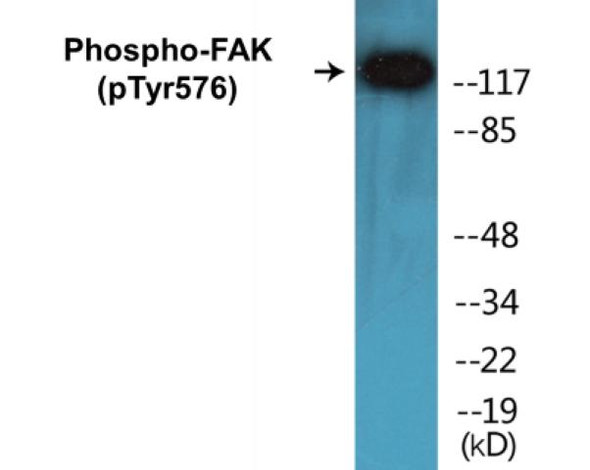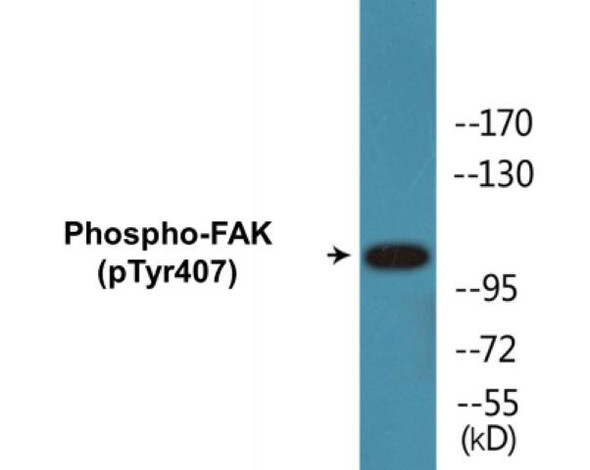Description
FAK (Phospho-Tyr576) Cell-Based ELISA Kit
The FAK (Phospho-Tyr576) Cell-Based ELISA Kit is a convenient, lysate- free, high throughput and sensitive assay kit that can monitor FAK phosphorylation and expression profile in cells. The kit can be used for measuring the relative amounts of phosphorylated FAK in cultured cells as well as screening for the effects that various treatments, inhibitors (ie. siRNA or chemicals), or activators have on FAK phosphorylation.
How does our FAK (Phospho-Tyr576) Fluorometric Cell-Based ELISA Kit work?
Qualitative determination of FAK (Phospho-Tyr576) concentration is achieved by an indirect ELISA format. In essence, FAK (Phospho-Tyr576) is captured by FAK (Phospho-Tyr576)-specific primary (1°) antibodies while Dye 1-conjugated and Dye 2-conjugated secondary (2°) antibodies bind the Fc region of the 1° antibody. Through this binding, the dye conjugated to the 2° antibody can emit light at a certain wavelength given proper excitation, hence allowing for a fluorometric detection method. Due to the qualitative nature of the Cell-Based ELISA, multiple normalization methods are needed:
| 1. | A monoclonal antibody specific for human GAPDH is included to serve as an internal positive control in normalizing the target RFU values. |
| 2. | An antibody against the nonphosphorylated counterpart of FAK (Phospho-Tyr576) is also provided for normalization purposes. The RFU values obtained for non-phosphorylated FAK can be used to normalize the RFU value for phosphorylated FAK. |
FAK (Phospho-Tyr576) Fluorometric Cell-Based ELISA Kit -Information
| Product Name: | FAK (Phospho-Tyr576) Fluorometric Cell-Based ELISA Kit |
| Product Code/SKU: | FBCAB00020 |
| Description: | The FAK (Phospho-Tyr576) Fluorometric Cell-Based Phospho ELISA Kit is a convenient, lysate-free, high throughput and sensitive assay kit that can monitor FAK (Phospho-Tyr576) protein phosphorylation and expression profile in cells. The kit can be used for measuring the relative amounts of phosphorylated FAK (Phospho-Tyr576) in cultured cells as well as screening for the effects that various treatments, inhibitors (ie. siRNA or chemicals, or activators have on PTK2 phosphorylation. |
| Dynamic Range: | > 5000 Cells |
| Detection Method: | Fluorometric |
| Storage/Stability: | 4°C/6 Months |
| Reactivity: | Human, Mouse, Rat |
| Assay Type: | Cell-Based ELISA |
| Database Links: | Gene ID: 5747, UniProt ID: Q05397, OMIM #: 600758, Unigene #: Hs.395482 |
| Format: | Two 96-Well Plates |
| NCBI Gene Symbol: | PTK2 |
| Sub Type: | Phospho |
| Target Name: | Phospho-FAK (Tyr576) |
Kit Principle
Figure: Schematic representation of Assay Genie Cell-Based Fluorometric ELISA principle
Kit components | Quantity |
| 96-Well Black Cell CultureClear-Bottom Microplate | 2 plates |
| 10X TBS | 24 ml |
| Quenching Buffer | 24 ml |
| Blocking Buffer | 50 ml |
| 15X Wash Buffer | 50 ml |
| Primary Antibody Diluent | 12 ml |
| 100x Anti-Phospho Target Antibody | 60 µl |
| 100x Anti-Target Antibody | 60 µl |
| Anti-GAPDH Antibody | 110 µl |
| Dye-1 Conjugated Anti-Rabbit IgG Antibody | 6 ml |
| Dye-2 Conjugated Anti-Mouse IgG Antibody | 6 ml |
| Adhesive Plate Seals | 2 seals |
Additional equipment and materials required
The following materials and/or equipment are NOT provided in this kit but are necessary to successfully conduct the experiment:
- Fluorescent plate reader with two channels at Ex/Em: 651/667 and 495/521
- Micropipettes capable of measuring volumes from 1 µl to 1 ml
- Deionized or sterile water (ddH2O)
- 37% formaldehyde (Sigma Cat# F-8775) or formaldehyde from other sources
- Squirt bottle, manifold dispenser, multichannel pipette reservoir or automated microplate washer
- Graph paper or computer software capable of generating or displaying logarithmic functions
- Absorbent papers or vacuum aspirator
- Test tubes or microfuge tubes capable of storing ≥1 ml
- Poly-L-Lysine (Sigma Cat# P4832 for suspension cells)
- Orbital shaker (optional)
Kit Protocol
This is a summarized version of the kit protocol. Please view the technical manual of this kit for information on sample preparation, reagent preparation and plate lay out.
| 1. | Seed 200 µl of desired cell concentration in culture medium into each well of the 96-well plates. For suspension cells and loosely attached cells, coat the plates with 100 µl of 10 µg/ml Poly-L-Lysine (not included) to each well of a 96-well plate for 30 minutes at 37°C prior to adding cells. |
| 2. | Incubate the cells for overnight at 37°C, 5% CO2. |
| 3. | Treat the cells as desired. |
| 4. | Remove the cell culture medium and rinse with 200 µl of 1x TBS, twice. |
| 5. | Fix the cells by incubating with 100 µl of Fixing Solution for 20 minutes at room temperature. The 4% formaldehyde is used for adherent cells and 8% formaldehyde is used for suspension cells and loosely attached cells. |
| 6. | Remove the Fixing Solution and wash the plate 3 times with 200 µl 1x Wash Buffer for 3 minutes. The plate can be stored at 4°C for a week. |
| 7. | Add 100 µl of Quenching Buffer and incubate for 20 minutes at room temperature. |
| 8. | Wash the plate 3 times with 1x Wash Buffer for 3 minutes each time. |
| 9. | Dispense 200 µl of Blocking Buffer and incubate for 1 hour at room temperature. |
| 10. | Wash 3 times with 200 µl of 1x Wash Buffer for 3 minutes each time. |
| 11. | Add 50 µl of Primary Antibody Mixture P to corresponding wells for FAK (Phospho-Tyr576) detection. Add 50 µl of Primary Antibody Mixture NP to the corresponding wells for total FAK detection. Cover the plate with parafilm and incubate for 16 hours (overnight) at 4°C. If the target expression is known to be high, incubate for 2 hours at room temperature. |
| 12. | Wash 3 times with 200 µl of 1x Wash Buffer for 3 minutes each time. |
| 13. | Add 50 ul of Secondary Antibody Mixture to corresponding wells and incubate for 1.5 hours at room temperature in the dark. |
| 14. | Wash 3 times with 200 µl of 1x Wash Buffer for 3 minutes each time. |
| 15. | Read the plate(s) at Ex/Em: 651/667 (Dye 1) and 495/521 (Dye 2). Shield plates from direct light exposure. |
| 16. | Wash 3 times with 200 µl of 1x Wash Buffer for 5 minutes each time. |
FAK (Phospho-Tyr576) - Protein Information
| UniProt Protein Function: | FAK: a tyrosine kinase of the FAK family required for cell migration and contact-dependent survival signaling. Activated by tyrosine-phosphorylation in response to either integrin clustering induced by cell adhesion or antibody cross-linking, or via G-protein coupled receptor (GPCR) occupancy by ligands such as bombesin or lysophosphatidic acid, or via LDL receptor occupancy. Downstream of integrins and Src, upstream of Ras/MAPK. Localizes to focal adhesions that form between cells growing in the presence of extracellular matrix constituents. Interacts with CAS family members and with GIT1, SORBS1 and BCAR3. Interacts with Shb. Required for full Ras transformation of fibroblasts. Increased expression in breast and other cancers, related to chromosome 8q amplification. Overexpression and activation associated with increased migration, invasion and progression of ovarian cancer, and with progression in hepatocellular carcinoma, thyroid cancer, and acute myelogenous leukemia. siRNA increases chemosensitivity of pancreatic adenocarcinoma xenografts. Inhibitor: ISI15421 (antisense). Four splice-variant isoforms have been observed. |
| UniProt Protein Details: | Protein type:Kinase, protein; Protein kinase, tyrosine (non-receptor); EC 2.7.10.2; Protein kinase, TK; TK group; Fak family Chromosomal Location of Human Ortholog: 8q24.3 Cellular Component: extrinsic to internal side of plasma membrane; cytoskeleton; focal adhesion; lamellipodium; apical plasma membrane; cytoplasm; stress fiber; plasma membrane; microtubule organizing center; cell cortex; cytosol; nucleus Molecular Function:JUN kinase binding; signal transducer activity; protein binding; protein-tyrosine kinase activity; non-membrane spanning protein tyrosine kinase activity; SH2 domain binding; actin binding; protein kinase binding; ATP binding; protein kinase activity; receptor binding Biological Process: heart morphogenesis; axon guidance; extracellular matrix organization and biogenesis; peptidyl-tyrosine phosphorylation; establishment of nucleus localization; apoptosis; protein amino acid autophosphorylation; neuron migration; cell motility involved in cell locomotion; negative regulation of synaptogenesis; regulation of cell shape; regulation of cell adhesion mediated by integrin; transforming growth factor beta receptor signaling pathway; positive regulation of cell proliferation; ephrin receptor signaling pathway; negative regulation of axonogenesis; angiogenesis; vasculogenesis; placenta development; cell structure disassembly during apoptosis; integrin-mediated signaling pathway; epidermal growth factor receptor signaling pathway; platelet activation; central nervous system neuron axonogenesis; regulation of osteoblast differentiation; positive regulation of phosphoinositide 3-kinase activity; signal complex assembly; cytoskeleton organization and biogenesis; microtubule cytoskeleton organization and biogenesis; negative regulation of organ growth; regulation of cell proliferation; positive regulation of phosphoinositide 3-kinase cascade; positive regulation of protein kinase B signaling cascade; embryonic development; establishment of cell polarity; positive regulation of protein kinase activity; regulation of focal adhesion formation; endothelial cell migration; innate immune response; positive regulation of protein amino acid phosphorylation; negative regulation of cell-cell adhesion; blood coagulation; vascular endothelial growth factor receptor signaling pathway; regulation of cytoskeleton organization and biogenesis; negative regulation of apoptosis; positive regulation of cell migration |
| NCBI Summary: | This gene encodes a cytoplasmic protein tyrosine kinase which is found concentrated in the focal adhesions that form between cells growing in the presence of extracellular matrix constituents. The encoded protein is a member of the FAK subfamily of protein tyrosine kinases but lacks significant sequence similarity to kinases from other subfamilies. Activation of this gene may be an important early step in cell growth and intracellular signal transduction pathways triggered in response to certain neural peptides or to cell interactions with the extracellular matrix. Several transcript variants encoding different isoforms have been found for this gene, but the full-length natures of only three of them have been determined. [provided by RefSeq, Dec 2010] |
| UniProt Code: | Q05397 |
| NCBI GenInfo Identifier: | 3183518 |
| NCBI Gene ID: | 5747 |
| NCBI Accession: | Q05397.2 |
| UniProt Secondary Accession: | Q05397,Q14291, Q8IYN9, Q9UD85, B4E2N6, F5H4S4, J3QT16 |
| UniProt Related Accession: | Q05397 |
| Molecular Weight: | 1052 |
| NCBI Full Name: | Focal adhesion kinase 1 |
| NCBI Synonym Full Names: | protein tyrosine kinase 2 |
| NCBI Official Symbol: | PTK2 |
| NCBI Official Synonym Symbols: | FAK; FADK; FAK1; FRNK; PPP1R71; p125FAK; pp125FAK |
| NCBI Protein Information: | focal adhesion kinase 1; FADK 1; PTK2 protein tyrosine kinase 2; FAK-related non-kinase polypeptide; focal adhesion kinase isoform FAK-Del33; focal adhesion kinase-related nonkinase; protein phosphatase 1 regulatory subunit 71; protein phosphatase 1, regulatory subunit 71 |
| UniProt Protein Name: | Focal adhesion kinase 1 |
| UniProt Synonym Protein Names: | Focal adhesion kinase-related nonkinase; FRNK; Protein phosphatase 1 regulatory subunit 71; PPP1R71; Protein-tyrosine kinase 2; p125FAK; pp125FAK |
| Protein Family: | Focal adhesion kinase |
| UniProt Gene Name: | PTK2 |
| UniProt Entry Name: | FAK1_HUMAN |







